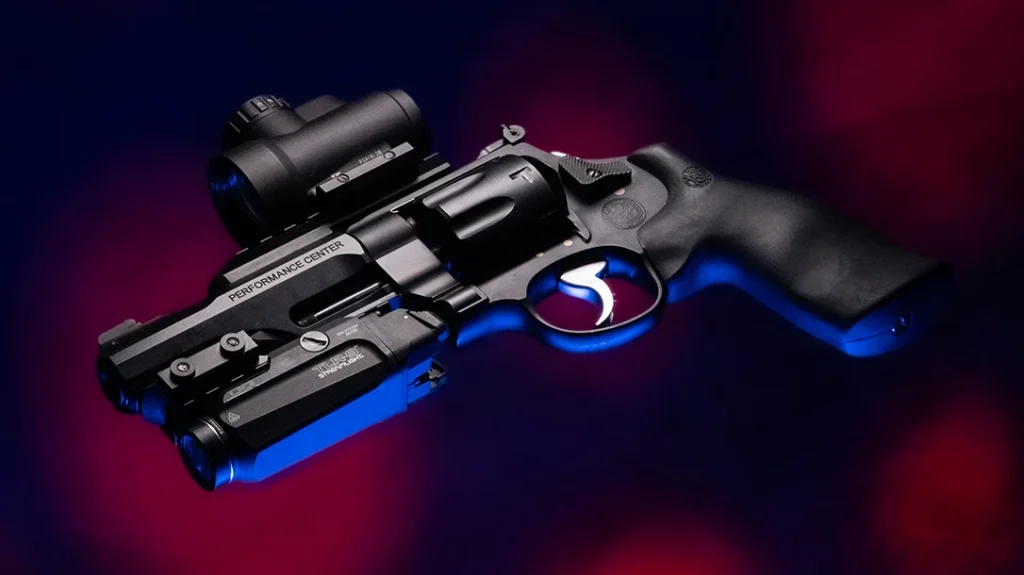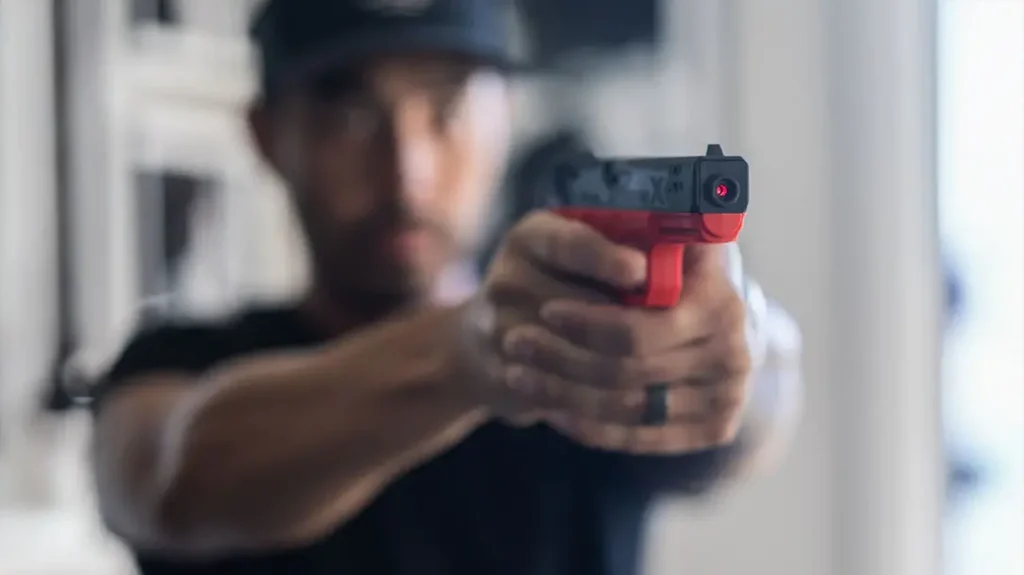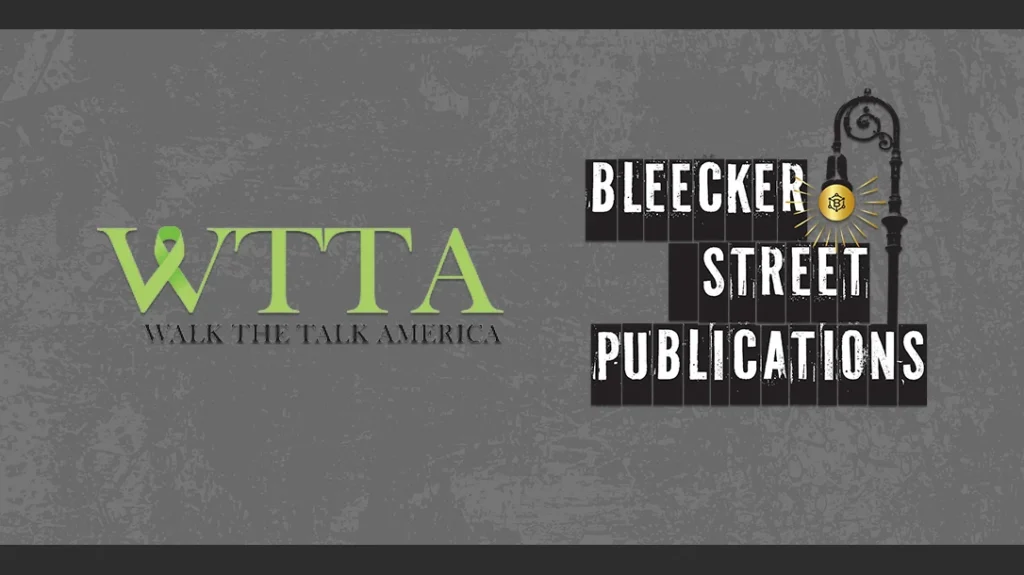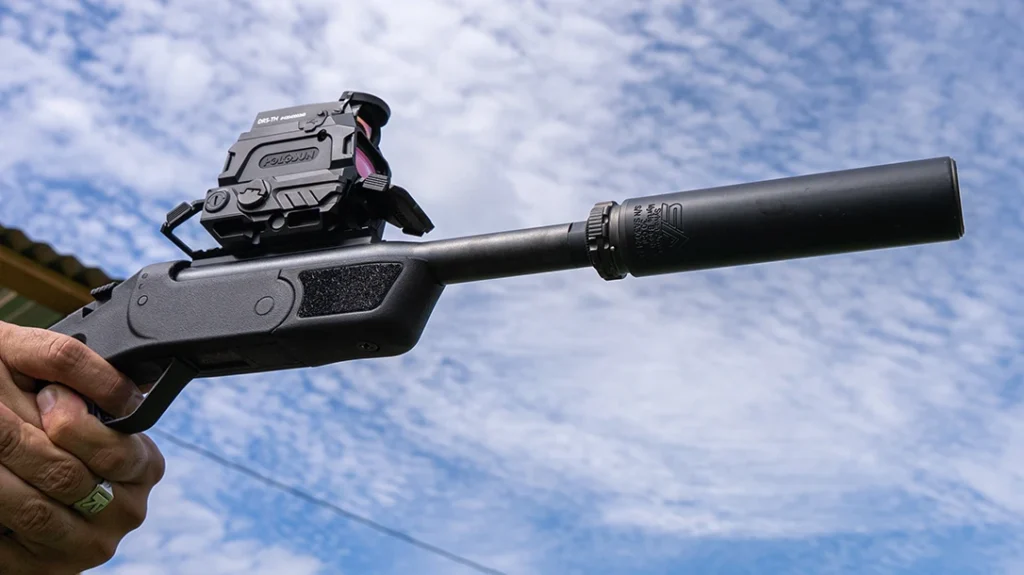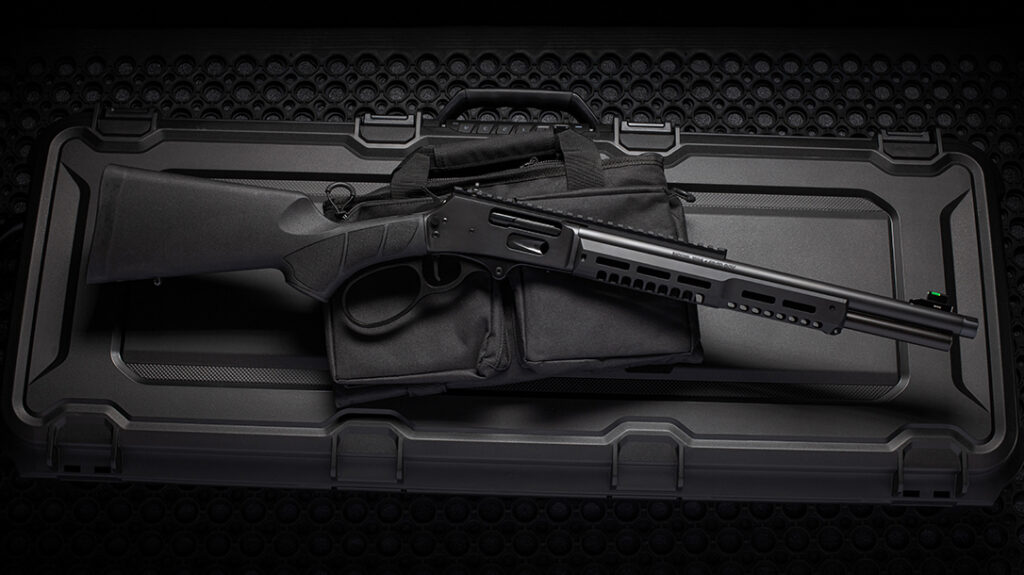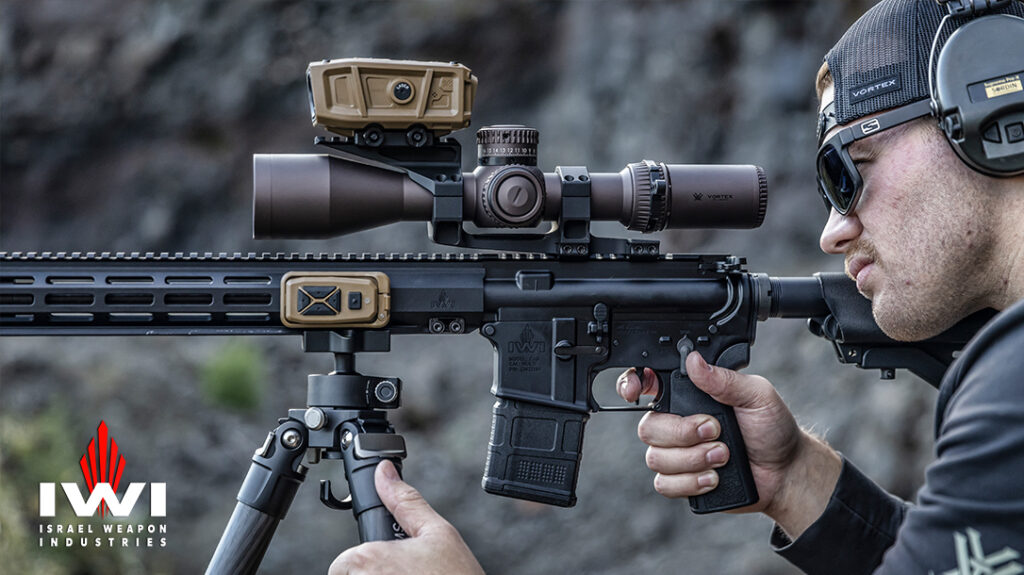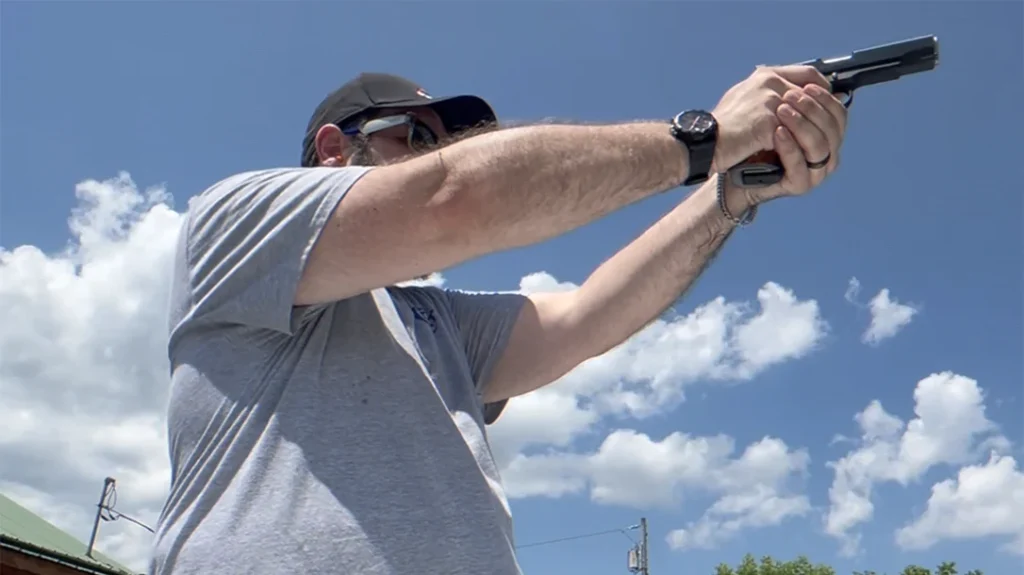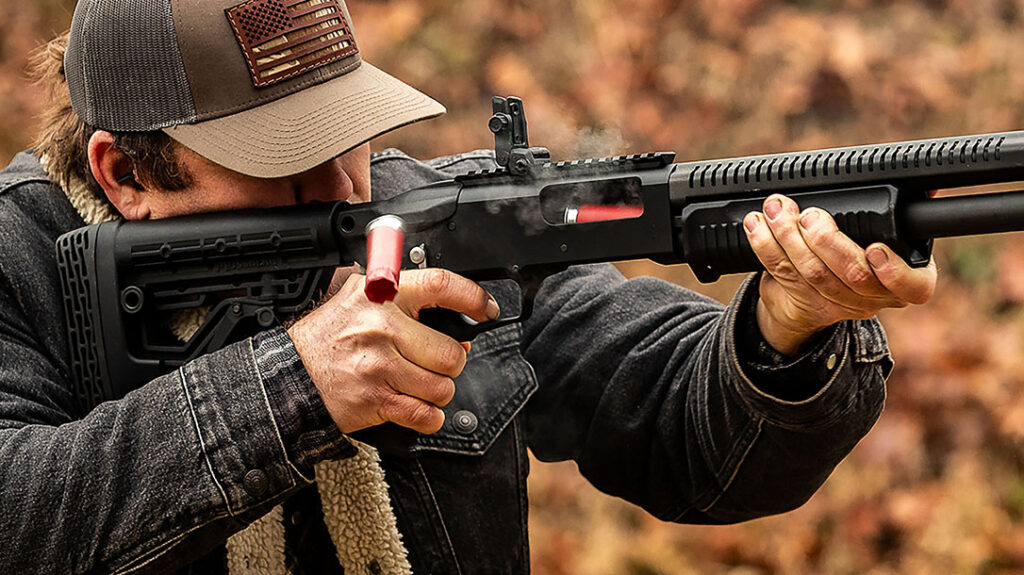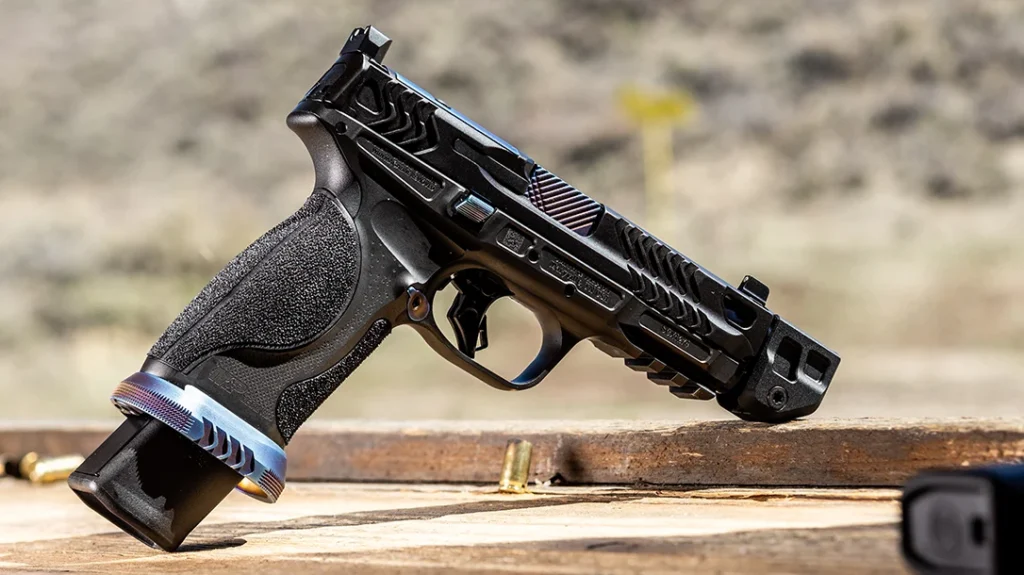Over the years (30+), the small arms training I sought was predominantly tactical in nature. Recently, I decided to take a different tack to increase my skill level with a handgun. This was prompted when a great opportunity presented itself in the form of Ken Bloxton’s Origin Shooting arriving at my home range, Echo Valley Training Center (EVTC). While there, Origin Shooting ran the Falling Steel Outlaw Pistol Match, and I participated. Here is how it went.
The Origin Shooting Falling Steel Outlaw Pistol Match
I have not forsaken defensive-oriented training. For example, tactical/personal defense classes are still pursued with organizations such as Brett Harnish’s Justified Defensive Concepts. The classes are held numerous times a year at EVTC. The blending of training is beneficial, especially with the added bonus of embracing red dots on my handguns.
I think we all accept that professional competition shooters are the highest-skilled “pistoleers” in the world. After all, that is what they do for a living. Expending time and ammunition that most just cannot imagine.
Advertisement — Continue Reading Below
Tier 1 Special Operations units often invite world-class competition shooters to train with them. This is in an effort to squeeze out every possible advantage in running a handgun more efficiently and ruthlessly. After all, the physical aspects of shooting are the same in every realm. For example, grip, stance, weapon manipulation, trigger control, hand-eye speed, and coordination.
First World Problems
Once I decided to attend my first Origin Shooting Falling Steel Outlaw Match, the process of selecting a handgun began. For example, the OPEN Division allows the sighting method of your choice (irons or red dot), compensator, and unlimited magazine capacity. In the LIMITED Division, you are allowed iron sights and no larger than 140mm magazines (approximately 20 rounds). Finally, the OPTICS Division has a red dot and 140mm magazine caveat.
I know this will sound like a First World issue. However, I had to decide not only on the shooting division, but also on the handgun for each division. I don’t expect much sympathy on this matter. Frankly, it was enjoyable to reevaluate so many topics I have covered over the years with a fresh perspective.
Advertisement — Continue Reading Below

OPEN Division gave me a chance to revisit Staccato XC (irons then Trijicon SRO) and SIG Sauer P320 Spectre Comp with SIG ROMEO1PRO red dot. LIMITED Division had me with Dan Wesson DWX and SIG Sauer P226 X-Five. OPTIC started with Staccato C2 with Leupold DeltaPoint Pro and a Springfield Armory Echelon with EO Tech EFLX red dot.
Equipment can’t buy skill. However, it’s nice to know that you are using the best equipment, leaving no doubt the deficiencies are found in the image staring back at you in the mirror.
Advertisement — Continue Reading Below
This Is the Way
The most obvious personal defense handgun equipment upgrade over the last decade has to be red dot sights (RDS). My first articles on red dot use appeared in 2010, thus dating my own journey. Technology should not be used as a false crutch, substituting for diligent practice and training. However, red dots are a positive compared to the centuries-old iron sight concept.
With a red dot, a user can now focus on the target or threat as nature intends. Moreover, because the indexing of a red dot is far easier than multiple pieces of steel on opposite ends of a reciprocating slide, shooters find they can perform beyond what was considered possible with iron sights. All simply because the concept uses the eyes in a more normal manner.
With that said, those of us with tens of thousands of rounds fired via iron sights have some things to unlearn to truly unlock red dot potential. My red dot odyssey encompasses not only my own range time and practice, but numerous training sessions culminating recently with Origin Shooting and Justified Defensive Concepts.
Advertisement — Continue Reading Below

Origin Shooting’s founder is Ken Bloxton. Ken’s introduction into the shooting culture started after 9/11. He was a senior in high school, joining the Army soon after graduation. Following the Army, his foray into competitive shooting began.
He was the 2015 Two-Gun Nationals Champion and placed 5th in the Three-Gun Nationals the same year. He created Origin Shooting in 2017 with an emphasis on enhancing students’ speed on placing rounds on target accurately, even when combined with movement. This, after all, would facilitate better performance no matter the situation.
Advertisement — Continue Reading Below
Origin Shooting encourages competition to better define weaknesses, thereby allowing them to be overcome.
Running a Red Dot at the Outlaw Steel Match
I never doubted the accuracy improvement offered via red dot, especially as engagement distances increase. Red dots are the path forward. My quest has been to improve the speed of getting on target and transitioning between targets. My second Origin Shooting Falling Steel Match really brought this home.
I have purposely been using the same firearm—Staccato XC—for Origin Shooting matches. As a result, the progress—or lack thereof—could not be blamed on changing the handguns used. The first Falling Steel match was with iron sights, and the second with Trijicon SRO mounted.
Advertisement — Continue Reading Below

I was pleased with my first match performance and thought that SRO would take me over the top in the second match. Not so much. Times were sluggish, and the feeling of accuracy degradation increased more than in the first match, even with SRO mounted. It was time for me to get back to the basics.
Back To the Basics
Fortunately, Justified Defensive Concepts (JDC) was holding a Red Dot Pistol Essential class at EVTC a week after the second Origin Shooting Match. Brett Harnish is the founder and driving force of JDC.
Advertisement — Continue Reading Below
The JDC syllabus for the Red Dot course sounded perfect. To paraphrase…show the benefits of a red dot while helping solve the biggest drawback folks face when using one reliably. Finding your dot during the draw and maintaining visual contact with the red dot during strings of fire and after weapon manipulation could also be added.
JDC Red Dot Essentials was solid training. Of course, that’s to be expected from someone with Brett’s resume—Marine, Border Patrol Agent, and other LE positions. He stressed the importance of grip for initial red dot placement as well as target focus. Tracking the red dot up/down on the target during the multiple-round drill showed that grip is the key.

Advertisement — Continue Reading Below
Proper grip starts from the holster and sets the stage for the most efficient use of a red dot-equipped handgun. The majority of aiming any pistol—red dot or not—is achieved through kinesthetic awareness.
Kinesthetic awareness refers to the body’s understanding of the relative location and engagement of tension in its various parts. This especially pertains to red dots via proper grip and tension applied to the pistol as soon as possible with the shooting hand from the holster and the support hand close to the body under the dominant eye.
JDC emphasized aiming to see the back plate of the pistol in front of their nose or dominant eye. This will help find the red dot consistently and efficiently. The importance of repetition via range time, competition, and dry fire cannot be overstated.
Free Your Mind—The Rest Will Follow
My squad during the Origin Shooting Falling Steel matches included the man himself, Ken Bloxton. This was on purpose. It is a huge benefit to be able to watch him attack the stages of fire. Not to mention interacting with him when not on the firing line. The red dot training was taken to the next level when the opportunity to work with Ken one-on-one presented itself.
In Ken’s own words, “The goal is to build people into highly competent trigger pullers that can perform on demand, shoot multiple targets, and move without focusing on the underlying individual tasks. I want my customers’ shooting skills (Speed, Accuracy, and Movement) to become so good that when they’re doing it, they’re not thinking about how to do it, it just happens.”

Ken’s progression of training for handgun competency is safety, fundamentals, accuracy, shot calling, draw, reloads, multiple targets, and movement. It’s amazing what can be accomplished in a single day of high-quality training with someone like Ken.
However, a single day of training not followed up on or neglected in practice doesn’t get people very far. That’s why Origin Shooting offers training sessions, monthly competitions, and group practices at the club located on EVTC grounds.
Shot Calling
Nuanced improvements/advice were gained across the board. However, one aspect of working with Ken/Origin Shooting made a huge difference for my improvement—”shot calling.”
According to Ken, once you learn how to shoot the gun accurately, you need a way to judge whether your shots are getting the job done. “Shot calling” forces you to pay attention to the sights as you’re firing the gun fast. This prevents you from getting lazy with sight pictures.

When you are shooting, “shot calling” provides visual confirmation. Watch your sights or dot “lift” so you know where your bullets went without having to check downrange results. If you “call the shot” as good, based on reading your sights, you know you hit well and keep going. However, if you “call the shot” as bad, then you can apply a makeup shot at the speed of recoil.
Aim Small, Miss Small
All of this sounds like unobtainable shooting Zen until someone like Ken breaks it down for you. Look at a small spot where we want the rounds to go and aggressively force our eyes to focus there. When transitioning to another target, we aggressively move our eyes to that next spot as soon as the shot breaks.
A visual aggressiveness or “hyper-focus” is trained. Vision is what determines speed. We need to asses what we need to see in order to pull the trigger. Especially when we want to engage multiple targets at speed or rapid strings of fire.

The key is indexing the dot consistently, so you don’t have to adjust or search too much to find it. This leads back to grip. If the index is off and you need to adjust the dot when on target, you will be slower during initial shot breaks and during strings of fire when dealing with recoil.
Here is some more advice that sounds basic, but is crucial—Grip, grip, grip!
Competitions Like Outlaw Steel Matches Test Your Abilities
Competing is an excellent way to test abilities when under pressure. Shooters, even experienced ones, have more problems with this than almost anything else. The third Origin Shooting Falling Steel Match reinforced the work put in with Justified Defensive Concepts and Ken’s Origin Shooting.
Performance reflected the advantage of the methods extolled, with me placing in the Top 10 overall.



